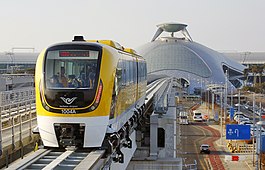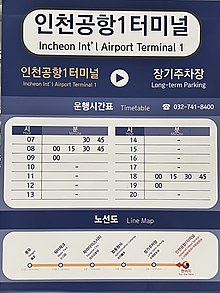Incheon Airport Maglev
 From Wikipedia - Reading time: 15 min
From Wikipedia - Reading time: 15 min
| Incheon Airport Maglev | |||||||||||||||||||||||||||||||||||||||||||||||||||||||||||||||||||||||||||
|---|---|---|---|---|---|---|---|---|---|---|---|---|---|---|---|---|---|---|---|---|---|---|---|---|---|---|---|---|---|---|---|---|---|---|---|---|---|---|---|---|---|---|---|---|---|---|---|---|---|---|---|---|---|---|---|---|---|---|---|---|---|---|---|---|---|---|---|---|---|---|---|---|---|---|---|
 | |||||||||||||||||||||||||||||||||||||||||||||||||||||||||||||||||||||||||||
 | |||||||||||||||||||||||||||||||||||||||||||||||||||||||||||||||||||||||||||
| Overview | |||||||||||||||||||||||||||||||||||||||||||||||||||||||||||||||||||||||||||
| Native name | 인천공항 자기부상철도 (仁川空港 磁氣浮上鐵道) Incheon Gonghang Jagi Busang Cheoldo | ||||||||||||||||||||||||||||||||||||||||||||||||||||||||||||||||||||||||||
| Status | Permanently Closed | ||||||||||||||||||||||||||||||||||||||||||||||||||||||||||||||||||||||||||
| Termini | |||||||||||||||||||||||||||||||||||||||||||||||||||||||||||||||||||||||||||
| Stations | 6 | ||||||||||||||||||||||||||||||||||||||||||||||||||||||||||||||||||||||||||
| Service | |||||||||||||||||||||||||||||||||||||||||||||||||||||||||||||||||||||||||||
| Type | Maglev | ||||||||||||||||||||||||||||||||||||||||||||||||||||||||||||||||||||||||||
| Operator(s) | Incheon Transit Corporation, Incheon International Airport Corporation | ||||||||||||||||||||||||||||||||||||||||||||||||||||||||||||||||||||||||||
| Rolling stock | 4 × 2-car Hyundai Rotem Ecobee | ||||||||||||||||||||||||||||||||||||||||||||||||||||||||||||||||||||||||||
| History | |||||||||||||||||||||||||||||||||||||||||||||||||||||||||||||||||||||||||||
| Opened | 3 February 2016[1] | ||||||||||||||||||||||||||||||||||||||||||||||||||||||||||||||||||||||||||
| Technical | |||||||||||||||||||||||||||||||||||||||||||||||||||||||||||||||||||||||||||
| Line length | 6.1 km (3.8 mi) | ||||||||||||||||||||||||||||||||||||||||||||||||||||||||||||||||||||||||||
| Number of tracks | 2 | ||||||||||||||||||||||||||||||||||||||||||||||||||||||||||||||||||||||||||
| Track gauge | 1,850 mm (6 ft 27⁄32 in) | ||||||||||||||||||||||||||||||||||||||||||||||||||||||||||||||||||||||||||
| Electrification | 1,500 V DC third rail linear motor | ||||||||||||||||||||||||||||||||||||||||||||||||||||||||||||||||||||||||||
| Operating speed | 80 km/h (50 mph) | ||||||||||||||||||||||||||||||||||||||||||||||||||||||||||||||||||||||||||
| Signalling | ATC/ATO | ||||||||||||||||||||||||||||||||||||||||||||||||||||||||||||||||||||||||||
| Highest elevation | 24.5 m (80 ft) | ||||||||||||||||||||||||||||||||||||||||||||||||||||||||||||||||||||||||||
| |||||||||||||||||||||||||||||||||||||||||||||||||||||||||||||||||||||||||||
| Incheon Airport Maglev | |
| Hangul | 인천공항 자기부상철도 |
|---|---|
| Hanja | |
| Revised Romanization | Incheongonghang jagibusangcheoldo |
| McCune–Reischauer | Inch'ŏnkonghang chagipusangch'ŏldo |
The Incheon Airport Maglev[2] was a maglev line in South Korea that opened on 3 February 2016 and closed on 1 September 2023.[3] It was the world's second commercially operating unmanned urban maglev line after Japan's Linimo. The trains were lighter, cutting construction costs in half.[4] The majority of construction was completed by November 2012.
The maglev linked Incheon International Airport Terminal 1 to Long Term Parking, Incheon Airport Administration Complex, Paradise City entertainment precinct, and Yongyu station and Leisure Complex while crossing Yeongjong Island.[5] The line is not part of the Seoul Metropolitan Subway System. It was free of charge for all riders. It initially operated between 09:00 and 18:00. Hours had been extended to between 07:30 and 20:00. Departures were every 15 minutes from all stations. It offered a transfer to Incheon International Airport Terminal 1 station of AREX.[6]
This maglev line specifically utilized electromagnetic suspension (EMS) and linear induction motor (LIM) propulsion.[7] The train was one of the first commercial maglev trains since the 1980s. Two more stages were planned of 9.7 km (6.0 mi) and 37.4 km (23.2 mi). Once completed it would have become a circular line.[8][9][10] These lines made up a core project that the Korea Rail Network Authority managed.[7]
Stations
[edit]

All stations are located in Jung District, Incheon.
| Station number | Station name | Transfer | Distance (km) | ||||||||
|---|---|---|---|---|---|---|---|---|---|---|---|
| English Name | Hangul | Hanja | Station | Total | |||||||
| M01 | Incheon International Airport Terminal 1 | 인천공항1터미널 | 仁川空港1터미널 | 0 | |||||||
| M02 | Long Term Parking | 장기주차장 | 長期駐車場 | 0.4 | |||||||
| M03 | Administration Complex | 합동청사 | 合同廳舍 | 0.5 | 0.9 | ||||||
| M04 | Paradise City | 파라다이스시티 | 파라다이스시티 | 0.4 | 1.3 | ||||||
| M05 | Water Park | 워터파크 | 워터파크 | 3 | 4.3 | ||||||
| M06 | Yongyu | 용유 | 龍遊 | 1.2 | 5.5 | ||||||
History
[edit]Origins
[edit]The maglev train, nicknamed ECOBEE, was co-developed by the Korea Institute of Machinery and Materials (known as the KIMM, which is part of the Korea University of Science and Technology) and Hyundai Rotem.[11][12] It is 6.1 kilometres (3.8 mi) long, with six stations and a 80 km/h (50 mph) operating speed (the design maximum speed is 110 km/h (68 mph)).[13]
This train was part of South Korea's Urban Maglev Program (UMP) which started in December 2006. This program reached out to prominent companies and organizations for rail development, like KIMM and Hyundai. The UMP represents Korea's push for R&D in maglev systems in order to engender a magnetic levitation transportation system to replace Korea's current urban transportation means. This train system is the result of a development project started in 1989 within the Korea Institute of Machinery and Materials (KIMM).[7]
The Ministry of Land, Infrastructure and Transport contributed 59% of the funds, around ₩217.4 billion (US$190.04 million), with Incheon Airport Corporation spending ₩78.7 billion (US$68.8 million) amounting to 25%, and Incheon City paying ₩18.9 billion (US$16.52 million) which comes to 6%. Additionally, ₩100 billion (US$87.42 million) was spent on research. This totals over ₩415 billion (US$362.78 million) of taxpayer money spent on the short lived project.[14]
Response to the COVID-19 pandemic
[edit]During the COVID pandemic the line was reduced to operate during rush hours only, departing Airport Terminal 1 Station every 15 minutes from 07:30 to 09:00 and 18:00-19:00. The reduced service was still operating in May 2022 but was expected to return to full-time service shortly after.

Closure
[edit]At its height in 2019, the Incheon Maglev saw just 4000 passengers each day.[15] This is only 11% of expected usage levels.[16] During the coronavirus pandemic, this number reduced by over 90% to just 300 daily passengers on average.[15]
The line was temporarily closed from 14 July 2022 due to maintenance and repair of the carriages not being completed on time (required every 3 years)[17] as per the Railroad Safety Act.
At the National Assembly Land, Infrastructure and Transport Committee meeting on 22 August 2022, Rep. Heo Jong-sik of Dong-gu, Incheon called for a “plan to reduce operating costs”, as annual maintenance fees hit ₩6 billion (US$5.24 million).[16]
On 17 October 2022, the National Assembly Transportation Committee held an inspection of the Incheon International Airport Corporation. They received stern critiques regarding the cost; it was revealed that Incheon Maglev required ₩500 billion (US$437.08 million) of investment over the next 10 years.[14] This is more than the cost of its initial construction.
On 16 June 2023, the Construction and Transportation Committee of Incheon City Council approved plans to convert the track from Maglev to orbital tram tracks.[18] The City Council argued that maintenance costs could be cut by up to 35% due to the difficulty and high cost in purchasing parts for Maglev trains.[19]
Changes and potential reopening
[edit]A proposal to cut costs was passed at the Incheon City Planning Committee on 26 July 2023. The new plan would reduce the operating time from 13 hours to 6 hours and decrease the number of trains from 103 to 25. It was projected that these changes would cut down annual operating costs from ₩8.2 billion (US$7.17 million) to ₩5.3 billion (US$4.63 million).[20]
On 3 January 2024, Incheon International Airport Corporation announced that operations are expected to resume from March 2024.[21]
Rolling stock
[edit]Hyundai Rotem both developed and manufactured the rolling stock for the line. The 4 trains consist of 2 carriages, namely A and B. Each carriage is 6 metres (19 ft 8 in) long, 2.7 metres (8 ft 10 in) wide and 3.45 metres (11 ft 4 in) high, they weigh 19 tonnes (19 long tons; 21 short tons) and have a starting acceleration and service brake of 1.1 m/s2 (3.6 ft/s2).
Past research
[edit]
Train systems such as the Incheon Airport Maglev use air brakes and electric brakes. However, magnetic levitation trains use regenerative braking and plugging braking as opposed to normal trains using regenerative braking and air braking. Regenerative braking is used when the speed of the motor exceeds the synchronous speed. When this happens, the motor changes current flow so that the motor brakes. After this happens, the excess power is converted to power for the motor. Plugging braking is used when the supply terminals are switched, but it is criticized as a wasteful practice, because in order to switch the terminals, an external resistor needs to be implemented as a stopper for the current flow. As a result, power is lost.[citation needed]
With the Urban Transit Maglev (now referred to as the "Incheon Airport Maglev") in South Korea as a test model, a study was conducted on exploring the relationship between the variation of slip frequency and energy efficiency of regenerative braking. The slip frequency decreases the limit for the regenerative extinction point. After testing, researchers noticed that this decrease of the frequency led to a decrease in the conversion time of the phase current back into the system. This decreased the required energy to brake, thus accumulating more regenerated power.[citation needed]
References
[edit]- ^ "도시형 자기부상철도 3일 개통…세계 두번째". 매일경제. 2 February 2016.
- ^ "Incheon maglev rail under construction". Korea JoongAng Daily. 3 August 2010. Retrieved 3 February 2014.
- ^ "About maglev train". Retrieved 30 December 2023.
- ^ "오늘 인천공항~용유동 자기부상열차 개통". 기호일보 - 아침을 여는 신문 (in Korean). 2 February 2016.
- ^ "KBS World". Retrieved 26 September 2010.
- ^ "인천공항 자기부상철도 3일 개통…무료로 운행한다". Yonhap News Agency (in Korean). 2 February 2016.
- ^ a b c Park, D. Y.; Shin, B. C.; Han, H. (1 November 2009). "Korea's Urban Maglev Program". Proceedings of the IEEE. 97 (11): 1886–1891. doi:10.1109/JPROC.2009.2030247. ISSN 0018-9219. S2CID 20955600.
- ^ Song, C. H.; Park, K.S.; Kim, C. K. (10–13 October 2011). Review on Incheon International Airport & Urban MagLev Interface. The 21st International Conference on Magnetically Levitated Systems and Linear Drives. Daejeon, Korea. p. 5. Archived from the original (PDF) on 21 December 2011. Retrieved 10 July 2018.
Phase 2 expansion line is planned to link coastal area and cover 9.7km with 5 train stations up to the international business complex II of IIA and Phase 3 or the last phase expansion line is designed to be a ring-type alignment circumnavigating Yeongjong Island around IIA, covering 37.4km with 16 train stations.
- ^ Han, Woojin. "영종자기부상열차 2단계". 미래철도DB (in Korean). Retrieved 9 July 2018.
- ^ Medimorec, Nikola (28 January 2012). "Maglev at Incheon International Airport to be completed this year". Kojects. Retrieved 10 July 2018.
Two more stages of construction are planned for the line; stage two is a 9.7km extension that continues from Yongyoo Station, past the planned Marine World and up to Dragon City. Though this stage was originally scheduled to be completed in time for the Asian Games, setbacks in the development of neighboring projects are still causing delays. The final stage will be significantly longer, a 37.4km extension that continues around the outer rim of the island and loop back to the airport.
- ^ "Maglev Train to Debut at Incheon in 2012". 26 June 2007. Retrieved 26 September 2010.
- ^ "Magnetic levitation train to operate in July". 14 May 2014. Retrieved 3 October 2014.
- ^ "Railway Gazette: Airport maglev demonstration line". Archived from the original on 15 June 2011. Retrieved 26 September 2010.
- ^ a b Jang, Byeong-geuk (18 October 2022). ""인천자기부상열차 실효성 없다" (Incheon Maglev is Ineffective)". Rail Economy News. Retrieved 17 January 2024.
- ^ a b "이용객 외면 인천공항 자기부상철도..."차라리 철거를"". YTN (in Korean). 15 October 2021. Retrieved 17 January 2024.
- ^ a b Jeong, Woon (22 August 2022). "매년 60억 부담 '자기부상철도' 중단 대신 효율화 주문 (Each year the Maglev will require 6 billion won of investment)". 경인일보 Gyeongin Ilbo (in Korean). Retrieved 17 January 2024.
- ^ "Ready for repairs". Korea JoongAng Daily. 13 July 2022. Retrieved 11 January 2023.
- ^ Park, Haeyoon (18 June 2023). "인천공항 자기부상열차, 관광열차 전환…폐지수순 밟나". Incheon Ilbo (in Korean). Retrieved 17 January 2024.
- ^ Lee, Min-woo (20 May 2023). "'혈세먹는 하마'... 인천공항 자기부상열차 중단한다". 경기일보 Gyeonggi Ilbo (in Korean). Retrieved 17 January 2024.
- ^ Song, Seungwon (26 July 2023). "인천공항 '자기부상철도'…첨단교통에서 결국 '궤도열차'로 전락". 경인방송 Gyeongin Bangsong (in Korean). Retrieved 17 January 2024.
- ^ Jeon, Yejoon (3 January 2024). "인천공항 자기부상열차, 3월부터 다시 달린다 (Incheon Airport Maglev's services to resume from March)". 중부일보 Joongboo Ilbo (in Korean). Retrieved 17 January 2024.
External links
[edit]- About Maglev Train (English)
- Maglev promotional brochure (Korean)
- Future Rail Database (Korean) "인천공항 자기부상열차"
- "Maglev Test," Korea JoongAng Daily (English) "Maglev Test"
 KSF
KSF